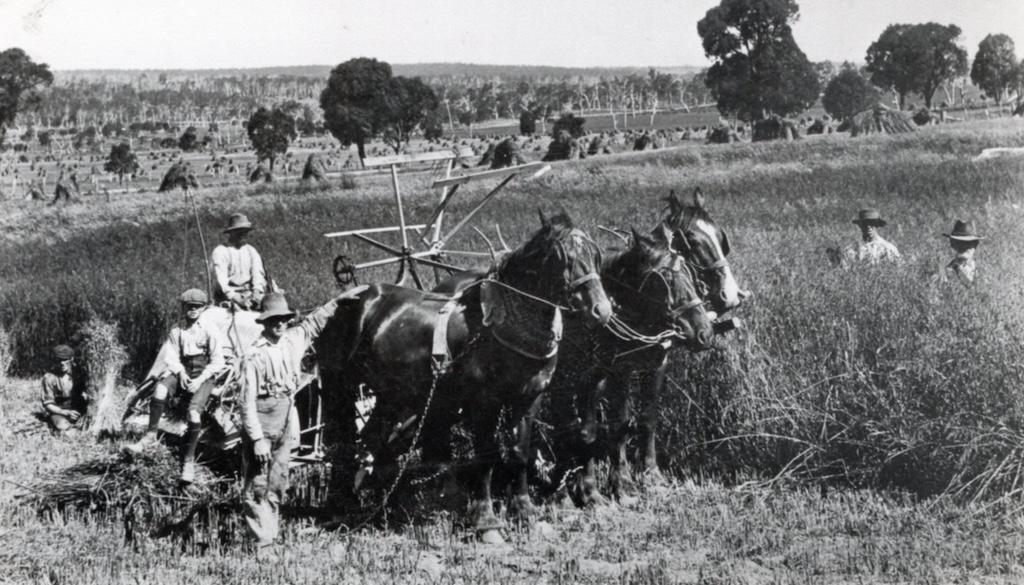
Three men and two boys stooking hay near Crookwell, working behind a team of three heavy horses. The stooks would later be piled up for storage and cut up for chaff to feed horses. Photo: Dell Bungay collection.
Taken in the Crookwell district sometime in the 1900s, this photograph of a horse-drawn reaping binder has brought back memories for people who either stooked hay, or were mesmerised by the ingenuity of early farm machinery.
Before tractors replaced horses on farms, stooking hay to dry it before storage was a common site across the rural landscape.
A prolific source of historic photos from Crookwell, Dell Bungay says the photograph was given to her by her grandmother Emily Willis, the daughter of Stephen Vidler. Del speculates it may have been taken in a paddock at ‘Rosehill’ which belonged to the Vidlers.
Crookwell cattleman and historian John Carter of ‘Lake Edward’ who well knows the landscape finds it hard to say exactly where the horse-drawn harvesting was happening, especially as there are no buildings to be seen anywhere.
He says it is more likely to be west of Cotta Walla. “I find it extraordinary the number of stooks stretching into the distance,” he said.
John said Stephen Vidler was a real goer back in the early history of the district and a founder in the late 1800s of the A.P. and H. Society. “He had ploughing matches on his property. He was a fellow with a lot of initiative and he did live at Rosehill, there’s no question about that.”
Horse-drawn reaping binders, with their many wheels, chains and sprockets were described as the closest thing to perfection when they arrived in Australia in the late 1800s.
The horse-drawn binders were later refitted for tractors, but their design changed little. Growing up in Wheeo, southwest of Crookwell, Bryson Banfield drove a small tractor on their 380-acre farm while his father Gordon rode on the Massey Harris binder imported from the United Kingdom, operating all the levers and height adjustments and sheaf carrier on the end of the machine.
“It was fascinating to go round and round the paddock seeing the hay falling into the canvas and going up the machine,” Bryson said. “I still can’t work out how the knotter tied a knot on a sheaf of hay.
“It was an intriguing thing to watch, because (the binder) had the battens coming down, pushing the hay over onto the knife, down onto the canvas belt, which took it up to the top of the machine,” he said.
When enough hay was gathered in, the machine could tie a knot, cut the string and flip the hay onto a little trailing arm that was out the right-hand side of the binder.
“You would leave that hay there until you had five or six sheaves of hay, then you hit a lever and it would put all those sheaves of hay into one heap,” he said. “Then you would come along afterwards and stook the hay.”
Seven to nine sheaves were placed into one stook and left for a few days to get all the moisture out of the hay. “Then you would come along with a truck or trailer, load the hay on and take it in to make a big stack out of it,” Bryson said.
“My father was an expert on building a haystack with the sheaves from the binder,” he said. Bryson left Wheeo in 1967 when he was 17 and became a wool classer.
In 1885 the Australian Town and Country Journal announced the arrival of the Osborne iron harvester, mower and binder, as another of the many implements “brought to perfection through experience gained in the Australian colonies”.
The name ‘Osborne Iron Harvester and Binder’ does not fully explain the merits of this machine, the journal said.
“Many makers use the term ‘iron’ nowadays. This Osborne machine, however, is constructed solely of wrought and malleable iron; driving gear is dispensed with, which will delight farmers to hear; the knife and binder are driven from the simple pair of sprocket wheels with a chain.
The journal marvelled at the machine’s ability to tie the sheaves, a marvel of simplicity. “The construction is after the Appleby principle, but in this new machine it only consists of a knotter jaw, twine holder and knife, dispensing with some 40 odd pieces as used on Appleby binders.”
Baling hay has come a long way since those days.







